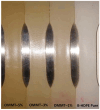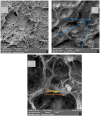Sugarcane-Based Polyethylene Biocomposite Reinforced with Organophilic Montmorillonite Clay: Experimental Characterization and Performance Evaluation
- PMID: 39599306
- PMCID: PMC11598152
- DOI: 10.3390/polym16223215
Sugarcane-Based Polyethylene Biocomposite Reinforced with Organophilic Montmorillonite Clay: Experimental Characterization and Performance Evaluation
Abstract
With the growing human awareness of trying to reduce the environmental impact in today's world, the development of new sustainably based materials has been the increasing focus of industry and academia. Biocomposites are environmentally friendly materials produced from raw materials synthesized from renewable sources. In this sense, this work aims to characterize and evaluate the mechanical and thermal performances of biocomposites manufactured from a thermoplastic matrix of high-density bioethylene and obtained from ethanol produced from sugarcane and reinforced with organophilic montmorillonite clay. For this, polyethylene grafted with maleic anhydride (PE-g-MA) was used as a compatibilizer. Dry biocomposites with 1, 3, and 5% organophilic montmorillonite clay, by weight, were subjected to structural (FTIR and DRX), thermal (DSC), thermogravimetric (TG/DTG), thermodynamic-mechanical (DMA), morphological (SEM and MET), and mechanical (tensile, flexural, impact, and shore D hardness tests) characterizations. The DMA experiments were carried out within the viscoelastic region of the polymer. From the obtained results, we notice that, in general, there was an increase in the properties of high-density biopolyethylene (B-HDPE) (without compromising its processability), and therefore, the automotive application of biocomposites compatible with PE-g-MA, containing low levels of organophilic montmorillonite clay, is recommended.
Keywords: biopolymers; compatibility; mechanical properties; organophilic montmorillonite.
Conflict of interest statement
The authors declare no conflicts of interest.
Figures







References
-
- Vargas Mores G., Pauletto C., Finocchio C.P.S., Barichello R., Pedrozo E.A. Sustainability and innovation in the Brazilian supply chain of green plastic. J. Clean. Prod. 2018;177:12–18. doi: 10.1016/j.jclepro.2017.12.138. - DOI
-
- Raquez J.M., Habibi Y., Murariu M., Dubois P. Polylactide (PLA) based nanocomposites. Prog. Polym. Sci. 2013;38:1504–1542. doi: 10.1016/j.progpolymsci.2013.05.014. - DOI
-
- Ehman N.V., Ita-Nagy D., Felissia F.E., Vallejos M.E., Quispe I., Area M.C., Chinga-Carrasco G. Biocomposites of Bio-Polyethylene Reinforced with a Hydrothermal-Alkaline Sugarcane Bagasse Pulp and Coupled with a Bio-Based Compatibilizer. Molecules. 2020;25:2158. doi: 10.3390/molecules25092158. - DOI - PMC - PubMed
-
- Hassan M.L., Rowell R.M., Fadl N.A., Yacoub S.F., Christainsen A.W. Thermoplasticization of Bagasse. I. Preparation and characterization of esterified bagasse fibers. J. Appl. Polym. Sci. 2000;76:561–574.
-
- Delgado J.M.P.Q., Lima A.G.B., Carvalho L.H. Moisture Transport in Polymer Composites Materials: Computactional Modeling and Experiments. 1st ed. Springer; Cham, Switzerland: 2022. - DOI
Grants and funding
- 18/2020/Fundação de Apoio à Pesquisa do Estado da Paraíba
- 308255/2022-4/National Council for Scientific and Technological Development
- https://doi.org/10.54499/UIDB/04708/2020/Fundação para a Ciência e Tecnologia
- https://doi.org/10.54499/UIDP/04708/2020/Fundação para a Ciência e Tecnologia
- https://doi.org/10.54499/2020.00828.CEECIND/CP1590/CT0004/Fundação para a Ciência e Tecnologia
LinkOut - more resources
Full Text Sources
Miscellaneous

